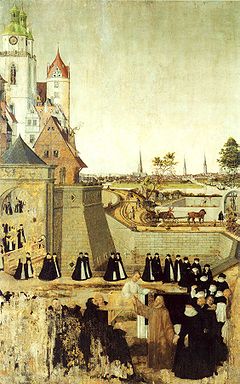To Loose It All to Be Raised Again Is a Singe

The raising of the son of the widow of Nain (or Naim)[ane] is an account of a miracle by Jesus, recorded in the Gospel of Luke chapter 7. Jesus arrived at the hamlet of Nain during the burying ceremony of the son of a widow, and raised the young man from the dead. (Luke vii:11–17)
The location is the hamlet of Nain, two miles southward of Mount Tabor. This is the first of 3 miracles of Jesus in the canonical gospels in which he raises the dead, the other ii being the raising of Jairus' daughter and of Lazarus.
Biblical account [edit]
The miracle is described thus in Luke 7:
xi Soon after Jesus went to a town named Nain, accompanied by His disciples and a big crowd. 12 And when He arrived at the gate of the town, a funeral procession was coming out. A swain had died, the only son of his mother, and she was a widow. And a large crowd from the town was with her. 13 And when the Lord saw her, His heart was filled with pity for her, and He said to her, "Do not weep". 14 And so He walked over and touched the coffin, while the pallbearers stood still. Jesus said to the dead man, "Immature man, I say to thee, arise!" And he who was dead, sat up and began to talk, and Jesus gave him back to his mother.
sixteen Then they all were filled with awe and praised God. And they said, "A bang-up prophet has risen amongst united states", and "God has visited His people".
17 This news about Jesus went out through all the country and the surrounding territory.
Estimation [edit]

Widow'southward Son Church at Nain which is the site of the miracle.
The raising of the son of the widow of Zarephath, past the Old Testament prophet Elijah (1 Kings 17), is seen by Fred Craddock as the model for this miracle, as there are several parallels in the details,[ii] especially some verbal parallels.[iii] The raising of the son of the woman of Shunem (ii Kings 4) by Elisha is also like, including the reaction of the people. In detail, the location of Nain is very shut to Shunem, identified with modern Sulam. Sinclair Ferguson calls attention to this every bit an example of a repeated pattern in the history of redemption.[4] He concludes that the pattern repetition
"comes to its fullness in the person of Jesus Christ, the great prophet who heals non just through delegated authority from God, but on his ain authority, without rituals or prayers, but with a unproblematic word of ability. Here is the great God and Saviour of Israel in the mankind"...[5]
The adult female in the story had lost both her husband and her simply son, then that there was no one left to support her. As she could non have inherited the country, the loss of her only son would have left her dependent on the charity of more afar relatives and neighbours.[6]
Both this account and the preceding one of the healing of the Centurion's servant (Luke seven:1–10) serve as a precursor to Jesus' balls to the imprisoned John the Baptist that He is truly, 'the ane who is to come' (7:19), since, 'the dead are raised.' (7:22).
Run into also [edit]
- Ministry building of Jesus
- Miracles of Jesus
- New Testament places associated with Jesus
- Parables of Jesus
- Church building of the Resurrection of the Widow'southward Son
Further reading [edit]
- Friedrich Justus Knecht (1910). . A Practical Commentary on Holy Scripture. B. Herder.
References [edit]
- ^ "Paragraph 2. On the 3rd Twenty-four hours He Rose from the Dead". Catechism of the Cosmic Church building. Retrieved 27 February 2022.
646 Christ'south Resurrection was not a return to earthly life, as was the instance with the raisings from the dead that he had performed before Easter: Jairus' daughter, the young homo of Naim, Lazarus. These actions were miraculous events, but the persons miraculously raised returned by Jesus' power to ordinary earthly life. At some particular moment they would die again. Christ'south Resurrection is essentially different. In his risen body he passes from the state of decease to another life beyond time and space...
- ^ Fred Craddock, Luke, 2009 ISBN 0664234356 page 43, 95–viii
- ^ The People's New Testament Commentary - M. Eugene Boring, Fred B. Craddock - 2004 Page 204 "seven:11-17 RAISING THE WIDOW'Due south SON This story is only in Luke, but information technology has many points of contact with the story of Elijah's raising the widow of Zarephath's son (one Kgs. 17:8-24), including such verbatim parallels as "he gave him to his mother" ..."
- ^ Sinclair Ferguson, Preaching Christ from the Sometime Testament Archived 2013-09-03 at the Wayback Automobile, Proclamation Trust, 2002, page 12.
- ^ Ferguson, page 13.
- ^ Sizer, Peter. "The Widow of Nain", Orthodox Research Establish, November, 1999
simmonsharanded99.blogspot.com
Source: https://en.wikipedia.org/wiki/Raising_of_the_son_of_the_widow_of_Nain
0 Response to "To Loose It All to Be Raised Again Is a Singe"
Enviar um comentário